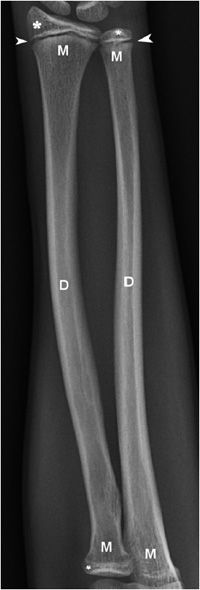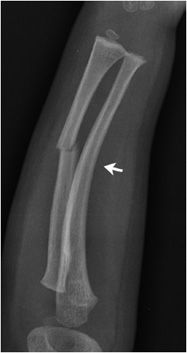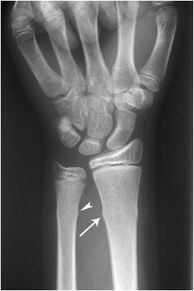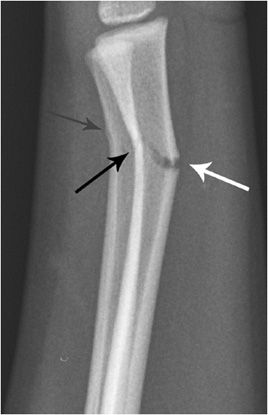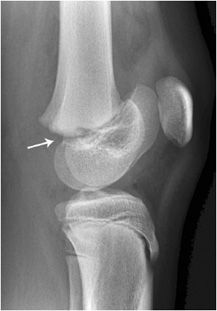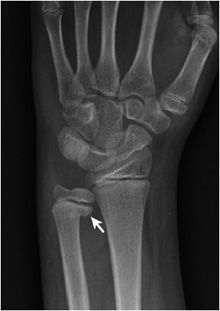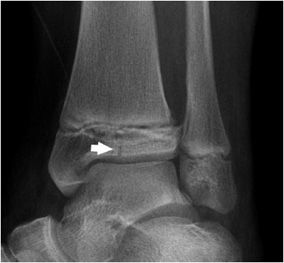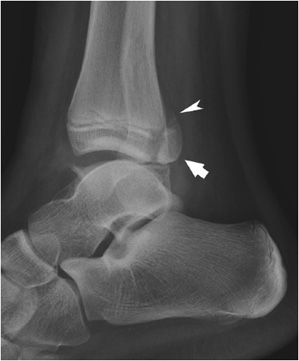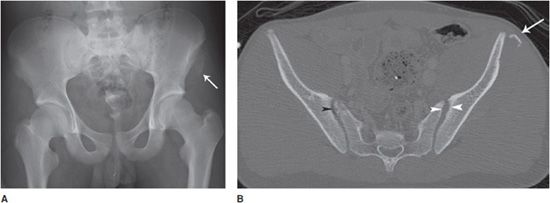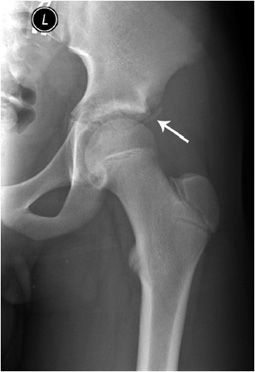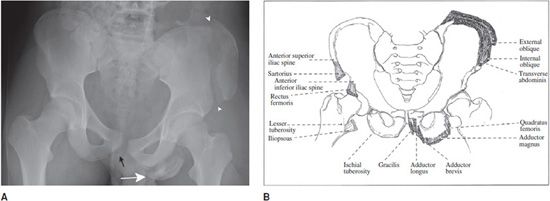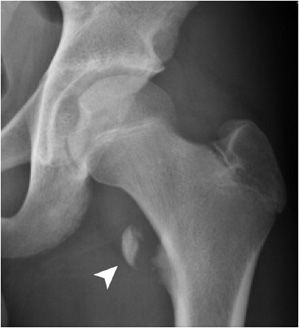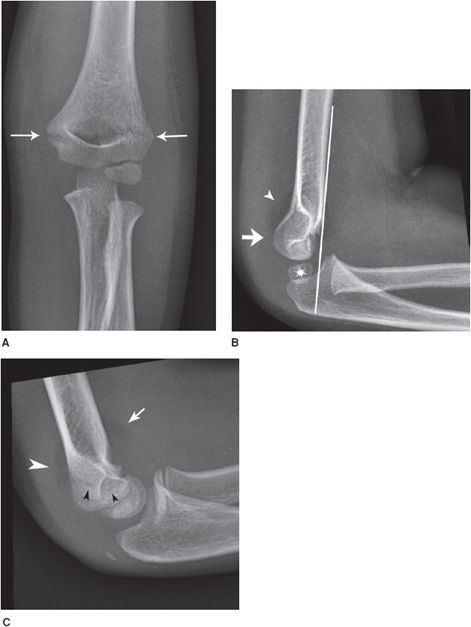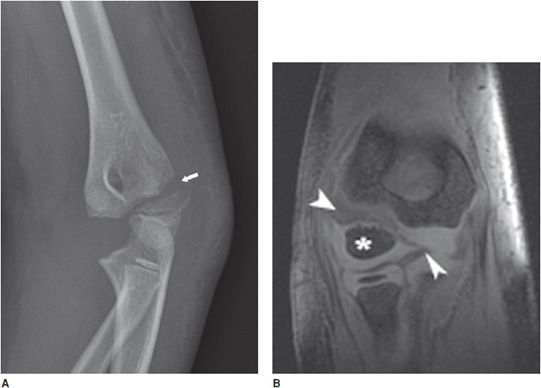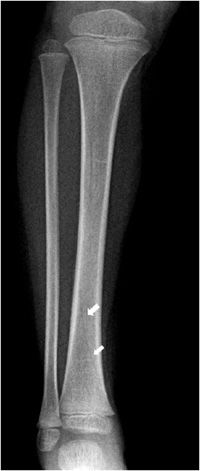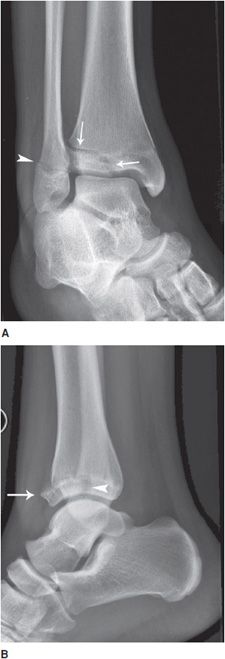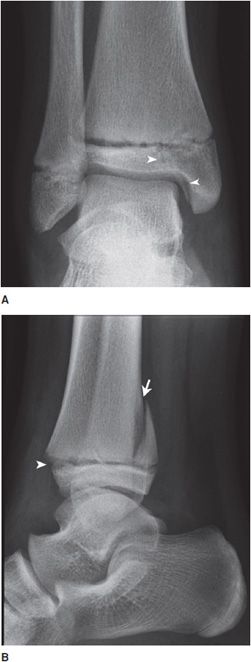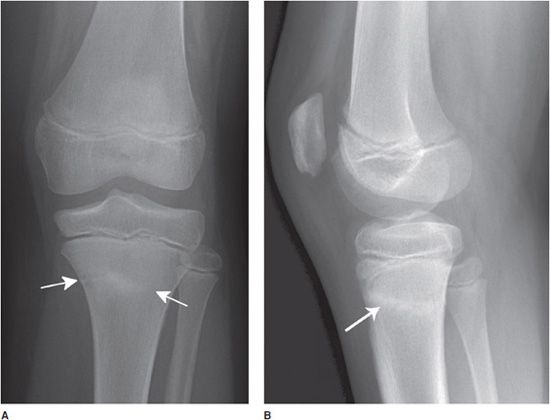Cornelia Wenokor, MD
Pediatric bones are softer than adult bones as they are more porous and less well mineralized. There are distinct anatomic differences between the pediatric and adult bone, and a nomenclature has evolved to identify the fractures and the different regions of the pediatric bone affected (Figure 5-1). Pediatric bones demonstrate a physis or growth plate, seen as a lucency between the flared metaphyseal region of the bone and the growth center or epiphysis. The shaft is called the diaphysis. Pediatric bones grow in length through endochondral ossification at the metaphyseal edge. The bone also grows in width across the diaphyseal aspect of the bone though membranous ossification. Healing of fractures in pediatric patients is more rapid than seen in adults.
Figure 5-1. Normal forearm. Normal frontal radiograph of pediatric forearm. Arrowheads show physes (growth plates). Asterisks denote epiphyses, (M) shows metaphyseal region, and (D) diaphyseal region.
The fracture patterns seen with pediatric trauma are unique to this patient population. Three common fracture types are the plastic deformity, the “buckle” or torus fracture, and the greenstick fracture. The plastic deformity is a bone that has bent without a visible fracture line. There are likely microscopic fractures on the concave or compression side of the injury.1 These types of fractures are often seen in the forearm or lower leg where two bones are present (Figure 5-2). The ulna and fibula are commonly affected, and there may be a complete fracture of the other paired long bone. Radiographic findings may be so subtle that it is not unusual to see the fracture deformity only after callus formation is identified.
Figure 5-2. Plastic fracture of ulna. Frontal forearm radiograph shows plastic deformity (bowing) of the ulna with excessive radial curvature of the shaft (arrow). Incident note made of midshaft radial fracture.
Buckle or torus fractures usually occur in the metaphyseal region of the bone, and they appear as small bumps on an otherwise smooth cortex. There is compression of the bone in this region. A careful search of all of the standard radiographic series is warranted, as the buckle may only be seen in one projection. Therefore, the fractures may be missed with one “spot” view done in the emergency room setting. The most frequent location is in the metaphyseal region of the dorsal cortex of the distal radius and ulna. Both bones may be affected (Figure 5-3).
Figure 5-3. Buckle (torus) fractures. Frontal wrist radiograph shows small buckle fractures in both ulnar (arrowhead) and radial (arrow) cortices.
A greenstick fracture is a unicortical fracture, with only the bent or tension side of the cortex interrupted. The fracture never penetrates both cortices, as one would expect in an adult (Figure 5-4).
Figure 5-4. Greenstick fracture of radius, and torus fracture of ulna. Lateral forearm radiograph shows unicortical greenstick fracture of distal radial diametaphyseal region (white arrow), plastic deformity of dorsal cortex at the same level (thick black arrow), and small buckle fracture diametaphyseal region of ulna (thin black arrow).
Epiphyseal injuries usually involve the physis, and are therefore often the source of healed fracture deformities. The Salter–Harris classification system is used to describe fractures that occur in the epiphysis, the physis, or the metaphyseal margin of the bone closest to the physis. Though the injury to the physis may not be seen radiographically, it is assumed that injury is propagated into the growth plate.2 Long-term complications of Salter fractures can include limb length discrepancy and joint incongruity.
All Salter injuries involve the physis. The injury in a Salter I fracture occurs only through the physis and the cleavage plane may be through the hypertrophic cartilage zone. Normally, if the periosteum is intact, there is no significant displacement of the epiphysis relative to the metaphyseal region. The only radiographic sign of injury may be a slightly widened physis. When displacement occurs, there is an increased propensity for osteonecrosis of the epiphysis or premature fusion of the growth plate to occur (Figure 5-5). Salter II fractures demonstrate a small metaphyseal, roughly triangular, fragment called the Thurston-Holland fragment (Figure 5-6). The periosteum is usually intact across this fragment and this can aid in fracture reduction. This type of injury in long bones like the femur occurs with hyperextension and varus or valgus stress.3
Figure 5-5. Salter I fracture. Lateral radiograph of the knee shows Salter I fracture of the distal femoral physis with anterior displacement of epiphysis relative to metaphysis (arrow).
Figure 5-6. Salter II fracture. Oblique wrist radiograph shows Salter II fracture of the distal ulnar metaphysis with distracted metaphyseal corner fragment (arrow) and slight widening of distal ulnar physis.
Salter III fractures pass through the ossified epiphysis and are often propagated to the articular surface of the joint (Figure 5-7). These fractures are seen in slightly older children and the growth plate may already be starting to close. Complications may result from incongruity of the articular surface. Salter IV injury is also intra-articular in nature and involves the epiphysis and metaphysis (Figure 5-8). Premature fusion of the physis is a concern with this type of fracture and this can cause angular deformity around the joint, or incongruity of the articular surface. Salter V injury is rare and consists of a crush injury to the growth plate.
Figure 5-7. Salter III fracture. Oblique ankle radiograph shows nondisplaced vertical Salter III fracture of the distal tibial epiphysis (arrow).
Figure 5-8. Salter IV fracture. Lateral ankle radiograph shows Salter IV fracture of the distal tibia. Fracture line intersects both the metaphysis (arrowhead) and the epiphysis (arrow) with some posterior displacement of both fracture fragments. Additional fibular diaphyseal and medial malleolar fractures are also present.
An apophysis is an accessory growth center that does not usually add to the length of the bone. The apophysis is attached to the bone by a physis as well. Muscles and tendons usually attach to these bony prominences, and they are therefore subject to stress and “avulsion” fractures. The pediatric pelvis is home to many sites of these avulsion injuries. The anterior superior iliac spine (ASIS) is the insertion site of the sartorius muscle and tensor fascia lata. Contraction during hip extension and knee flexion in sprinters or hurdlers can cause this injury (Figure 5-9A,B). The anterior inferior iliac spine is the insertion site of the reflected head of the rectus femoris muscle. Injury occurs with extension at the hip joint and a flexed knee. Soccer players can sustain these injuries (Figure 5-10). The ischial tuberosity is the site of attachment of the hamstring muscles that include the semitendinosus, semimembranosus, and biceps femoris muscles. These muscles flex the knee and extend the hip and are injured in athletes participating in track and soccer (Figure 5-11A). It is important to familiarize oneself with the variety of attachments around the pelvis (Figure 5-11B),4 as when these injuries heal they can be mistaken for bone tumors, instead of posttraumatic bony excrescences. Lesser trochanteric apophyseal avulsions are caused by sudden contraction of the iliopsoas muscle and will present clinically as anteromedial hip pain (Figure 5-12). These injuries are also seen in runners.
Figure 5-9. Anterior superior iliac spine (ASIS) avulsion. (A) Frontal pelvis radiograph shows ASIS avulsion (arrow) at origin of sartorius tendon. (B) Axial CT of pelvis confirms the finding (arrow). Additional mild diastasis of left sacroiliac (SI) joint is noted (white arrowheads) as well as vacuum phenomena in right SI joint (black arrowhead)
Figure 5-10. Anterior inferior iliac spine avulsion. Frontal left hip radiograph shows anterior inferior iliac spine avulsion (arrow), which is the origin of the rectus femoris tendon.
Figure 5-11. Pelvic avulsion fracture. (A) Subacute left ischial tuberosity avulsion with some healing (large white arrow), and acute avulsion at the adductor tendon insertion (black arrow) and vertical fracture through left ilium (arrowheads). (B) Anatomy of the origin and insertion sites of the pelvis. (From Tehranzadeh J. Avulsion and avulsion-like injuries of the musculoskeletal system. In: Tehranzadeh J, Serafini AN, Pais MJ, eds. Avulsion and Stress Injuries of the Musculoskeletal System. Karger, Basel (Switzerland); 1989:1-64, with permission.)
Figure 5-12. Avulsion of the lesser trochanter. Frontal hip radiograph shows lesser trochanteric apophyseal avulsion (arrowhead), which is the site of insertion of the iliopsoas tendon.
Fractures about the elbow joint are quite common in the pediatric age group and supracondylar fractures comprise approximately 60% of all pediatric elbow fractures.5 The fracture is usually transverse in nature, and a lateral image will demonstrate posterior displacement of the condylar bone fragment relative to the shaft. There are instances where identification of the fracture line can be quite difficult, and identifying the subtle posterior subluxation of the condyles may be key to the diagnosis (Figure 5-13A,B). The anterior humeral line is drawn across the distal humerus, and this line should intersect the capitellum between the anterior and middle thirds of this ossicle. If the line falls anterior to this point in the capitellum, then a supracondylar fracture should be strongly suspected. A true lateral view of the elbow in flexion will also be invaluable in identifying a positive posterior fat pad sign. Normally, there is a fat pad situated in the intercondylar region of the distal humerus. It is elevated and visible when an effusion is present (Figure 5-13C). In a setting of trauma, identification of a posterior fat pad is usually taken to mean that an occult intra-articular fracture is present. The literature is divided on the sensitivity and specificity of this finding in conjunction with a fracture.6,7 Effusions can also be a reactive phenomena, caused by entities like septic arthritis, inflammatory arthritis, neoplasm, and osteonecrosis. With the elbow in 90° of flexion, the anterior fat pad is often identified in normal individuals. It is a summation of the radial and coronoid fat pads that are normally overlying the coronoid fossa. Only when the elbow joint is distended and the anterior fat pad resembles a broad triangular “sail sign,” this finding can be considered a possible indication of fracture (Figure 5-13C).8
Figure 5-13. Supracondylar fracture of the elbow. (A) Frontal elbow radiograph with subtle fracture (arrows). (B) Lateral elbow radiograph shows anterior humeral line (white line) that does not intersect capitellum (asterisk), posterior displacement of condylar bone fragment (arrow), and posterior fat pad (arrowhead). (C) Lateral elbow radiograph with positive posterior fat pad sign (white arrowhead), anterior “sail” sign (arrow) and nondisplaced supracondylar fracture (black arrowheads).
Another common pediatric fracture is the lateral condylar fracture. This fracture is often best identified on oblique elbow views (Figure 5-14A). In some cases, the fracture begins in the metaphysis, crosses the physis, and enters the epiphyseal articular cartilage. As there is often so little ossification of the articular surface of the capitellum and trochlea present at the time of injury, it becomes impossible to estimate the degree of cartilage injury present and extent of incongruity. Therefore, some pediatric orthopedic surgeons will request MR to evaluate the true intra-articular extent of the fracture for preoperative planning (Figure 5-14B).
Figure 5-14. Lateral condylar fracture of the elbow. (A) Oblique radiograph of the elbow where fracture line is best seen (arrow). (B) Coronal MR gradient echo image of the elbow shows extension of lateral condylar fracture (arrowheads) through bright (white) cartilage covering distal humerus. Asterisk is the ossified portion of the capitellum.
The toddler’s fracture typically occurs in 1–4 years old children, after relatively innocuous or trivial trauma. Patients may be unable to bear weight or they may walk with a limp. These nondisplaced or minimally displaced fractures are seen in the distal tibial shaft, and radiologic findings are often quite subtle. Typically, there is an oblique fracture that exits the medial cortex (Figure 5-15). If there is a high index of suspicion, then additional oblique views may facilitate identification of the fracture.9
Figure 5-15. Toddler’s fracture. Frontal radiograph of tibia shows a hairline toddler’s fracture (arrows).
Two common fractures about the ankle often occur as the child is reaching skeletal maturity, in the second decade of life. The juvenile Tillaux fracture occurs through the lateral aspect of the distal tibial physis. The medial half of the physis closes earlier than the lateral half. The fracture line traverses the patent lateral physis and exits through the epiphyseal articular surface, in a similar manner to a Salter III fracture. The mechanism is external rotation and supination. If the lateral epiphyseal fragment is large enough, and displaced, then incongruity and posttraumatic osteoarthritis may result as a complication. Anatomic reduction is often performed with internal fixation (Figures 5-16A–C).
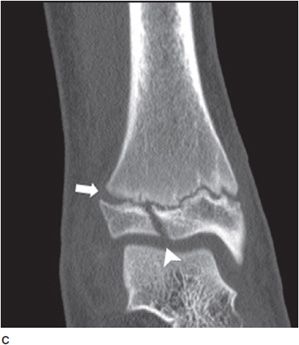
Figure 5-16. Tillaux fracture. (A) Oblique ankle radiograph demonstrates fracture through lateral margin of distal tibial epiphyseal region (arrows) and closed medial physis. Subtle slightly displaced Salter I fracture of the distal fibula (arrowhead) is also noted. (B) Lateral view shows anterior displacement of epiphyseal fragment (arrow) relative to the metaphysis and the fracture line (arrowhead) is also noted. (C) Coronal CT reformat with Tillaux fracture (arrowhead), and wide lateral physis (arrow).
The triplane fracture mechanism is again felt to be external rotation and supination. This fracture must be evaluated with a standard three-view radiographic ankle series, as the fracture is propagated in all three planes. One key to identifying this fracture type on radiographs is that it will appear to be a different type of Salter fracture in different projections. The example provided shows a Salter III fracture on the frontal image, but a Salter II fracture on the lateral view (Figure 5-17A,B). CT is used to precisely delineate the number of fracture fragments involved and displacement at the articular surface (Figure 5-17C–E).
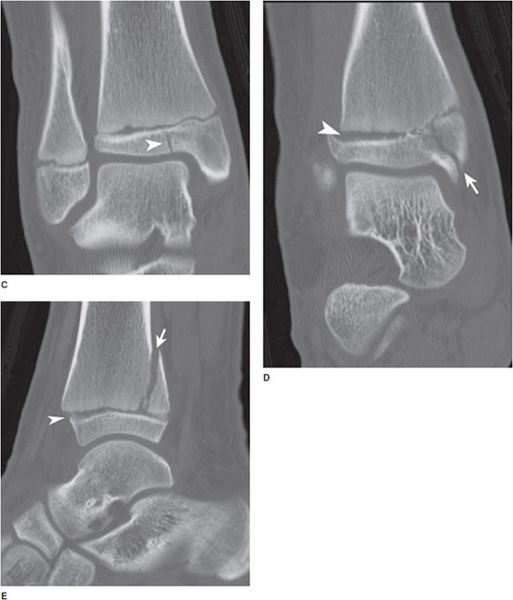
Figure 5-17. Triplane fracture. (A) Frontal ankle radiograph shows what appears to be a Salter III fracture of the distal tibia with the arrowheads showing the epiphyseal fracture component centrally and in the medial malleolus. (B) Lateral view of same patient shows what appears to be a Salter II fracture with posterior metaphyseal component (arrow) and widened physis (arrowhead). (C) Frontal CT reformat shows nondisplaced Salter III component through center of distal tibial epiphysis (arrowhead). (D) More anterior frontal CT reformat shows Salter III component in medial malleolus (arrow) and widened lateral physis (arrowhead). (E) Sagittal CT reformat shows Salter II component in posterior metaphysis (arrow) and wide anterior physis (arrowhead).
Stress fractures in children were considered a rare occurrence, but are now being seen with increasing frequency as organized sports grow in popularity. There are two types of stress fractures. The fatigue fracture is seen when repetitive abnormal stress is imposed on normal bone, and this is what is most frequently seen in a typical pediatric population participating in sports. The insufficiency fracture occurs with normal stress on abnormal bone, and the type of patient affected may be anorexic or have metabolic bone disease. The tibia is the most common site of the fatigue type of stress injury, and the fracture may appear as a dense band-like focus of sclerosis in the medullary canal (Figure 5-18A,B). Focal cortical thickening is also another radiographic sign of a healing stress fracture. MR can often diagnose these injuries before they are even seen on radiographs. Osseous bands of low signal intensity on T1-weighted images and corresponding high signal bands of bone marrow edema on T2-weighted images are diagnostic.10
Figure 5-18. Stress fracture. (A) Frontal knee radiograph shows band of sclerosis in tibial metaphysis (arrows) consistent with stress fracture. (B) Lateral knee radiograph shows similar band of sclerosis (arrow).
Stay updated, free articles. Join our Telegram channel

Full access? Get Clinical Tree


